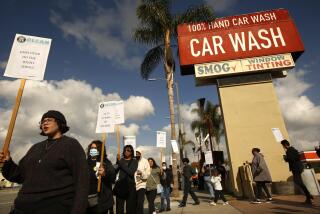Business Is Losing Liability Battle
- Share via
“Jury Gives Millions to IUD Victim.” “Fired Worker Takes Employer to Court, Wins Bundle.” “Toxic Waste Penalties Polluting Firms’ Balance Sheets.”
Dramatic headlines and rising costs have made business painfully aware of progressive expansion in their liability exposure in recent years. In response, firms have mounted a concerted effort to stem or even reverse this tide. A survey of what has been happening and why this counterattack has yielded mixed results offers some insights into prospects.
Over the last two decades, courts have made it easier for plaintiffs to obtain recovery for risky products while also recognizing new types of employment and environmental liability. Also, juries have become more generous in making damage awards.
California offers a prime example of the effects: Between 1960 and 1984, the average product liability award rose more than tenfold in some districts and reached over $660,000.
Although litigation may be as American as apple pie--and some firms may well be getting their just desserts--individual corporations and industries felt aggrieved and fought back. Proposition 51 was a successful attempt to limit damages payable by “deep pockets” defendants. State legislatures were lobbied to cap damage awards and restrict punitive damages. Also, strenuous efforts have been made to convince the judiciary that expanded liability engenders wider economic costs in the form of higher product prices, products withdrawn from the market, lower productivity and competitiveness, reduced employment.
Overall, these activities have met with mixed success both in California and elsewhere. Although more than 40 states have passed some type of “reform” by statute or initiative, these moves have failed to meet proponents’ expectations. Efforts directed at the judiciary seem to have had greater success, especially in California where the activism of the Rose Bird Court appears to have been slowed, if not reversed, since the appointment in 1987 of Chief Justice Malcolm Lucas.
These activities are likely to continue. But can business breathe a sigh of relief? Is the pendulum swinging back toward the days of more limited liability or is the current condition just a pause of liability expansion?
The answer, for several reasons, is probably not.
First, the plaintiffs’ bar has become far more sophisticated in handling suits against corporations. Specifics include greater sharing of information about cases, the use of computerized networks to disseminate successful arguments, the growth of specialized practices and experts and the development of complex economic analyses for calculating plaintiffs’ losses.
Second, increasing media publicity about liability is alerting the public to litigation options. At present, for example, less than 10% of persons injured in nonwork, product-related injuries consider filing a liability claim in contrast to about two-thirds of those injured in automobile accidents. That percentage is likely to increase as these individuals, like automobile accident victims, become aware of claim possibilities and become conditioned to making them.
The Dalkon Shield case provides a startling example. Prior to court-ordered notification, only 15,000 claims had been filed by users of the faulty intrauterine birth-control device. After the publicity, over 325,000 claims were made.
Third, and perhaps most important, public concern about the issues that are often at the heart of the expansion in corporate liability--notably hazardous wastes and products--is intense. Judges and legislators are unlikely to ignore these attitudes. Indeed, despite its recent more cautious approach to judicial activism, the California Supreme Court recently assessed retroactive liability for hazardous waste cleanup on insurance carriers.
Finally, Americans no longer believe, if ever they did, that what’s good for General Motors is good for the country. Public mistrust of corporations has risen sharply. Juries seem increasingly willing to pass on the cost and risk of injuries to the private sector.
For all these reasons and more, we are unlikely to return to the bygone era of limited corporate liability. Business may continue to win some battles, of course. Change may prove feasible on the environmental front, given the fact that players on all sides of that issue seem disenchanted with that status quo. However, the only real question is whether the upturn in corporate liability has leveled or merely slowed.
More to Read
Inside the business of entertainment
The Wide Shot brings you news, analysis and insights on everything from streaming wars to production — and what it all means for the future.
You may occasionally receive promotional content from the Los Angeles Times.










